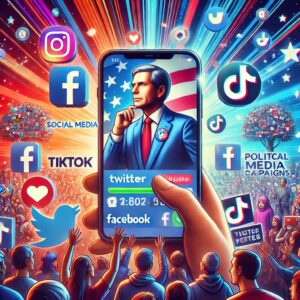Gone are the days when political campaigns relied solely on TV ads and public speeches. Today, social media platforms like Twitter, Facebook, and TikTok are where much of the political action happens. Campaigns have turned to these platforms not just as tools for connecting with voters but as powerful forces capable of swaying public opinion, driving engagement, and even changing the course of elections. But how exactly do these platforms shape the electoral landscape? Let’s take a closer look at the dynamic role of social media in modern political campaigns.
Social media allows politicians to connect with voters instantly, bypassing traditional media filters. Whether it’s a tweet from a candidate or a Facebook post from a campaign manager, information reaches voters in real time, giving candidates unprecedented control over their messaging. This immediate access means campaigns can quickly respond to events, issue clarifications, or reinforce their positions. However, the 24/7 nature of social media also makes campaigns vulnerable to missteps, where a single tweet or post can spark controversy.
One of the biggest advantages of social media is its ability to target specific audiences through ads. Platforms like Facebook and Instagram collect extensive data on users, allowing campaigns to segment voters based on demographics, interests, and even previous voting behavior. This data-driven approach lets campaigns tailor messages to resonate with specific groups, whether young voters on TikTok or suburban parents on Facebook. While effective, this level of targeting has raised questions about privacy and transparency, as well as concerns about echo chambers where voters see only content that aligns with their views.
TikTok dances, memes, and viral challenges might seem trivial, but they have become powerful tools for campaigns to engage young voters. Social media trends can rapidly amplify campaign messages, making politics more accessible and relatable to audiences who may not engage with traditional news. Memes, in particular, allow campaigns to express complex issues in simple, often humorous ways that are easy to share. However, these trends can be unpredictable, and what works for one candidate may backfire on another, as younger audiences are often quick to detect and reject inauthenticity.
Social media has also become a home for grassroots movements, where everyday people can organize, advocate, and fundraise for causes they care about. Platforms like Twitter and Instagram have helped drive movements around social justice, climate action, and healthcare reform. These movements can boost campaign visibility and even pressure candidates to address specific issues. For example, hashtags like #BlackLivesMatter and #MeToo started as grassroots campaigns on social media but grew into national conversations that have influenced political agendas and candidate platforms.
While social media offers new ways to reach voters, it also poses challenges, especially around misinformation. Fake news stories, manipulated images, and deepfake videos can quickly spread, influencing voter perceptions before fact-checkers can intervene. Campaigns must not only navigate these risks but also work to build trust and counter misinformation. In response, platforms have introduced fact-checking features, but the sheer volume of content makes it difficult to monitor everything effectively.
As social media continues to evolve, so will its role in elections. The platforms we rely on today may look completely different in the next election cycle, but one thing is clear: digital engagement is here to stay. Candidates who understand and harness the power of social media will continue to have an edge, as they can reach voters where they already are—scrolling, posting, and sharing online.
In the world of modern campaigns, social media is not just a tool; it’s a battleground, a megaphone, and a digital handshake. For better or worse, it has forever changed the way we experience politics.

